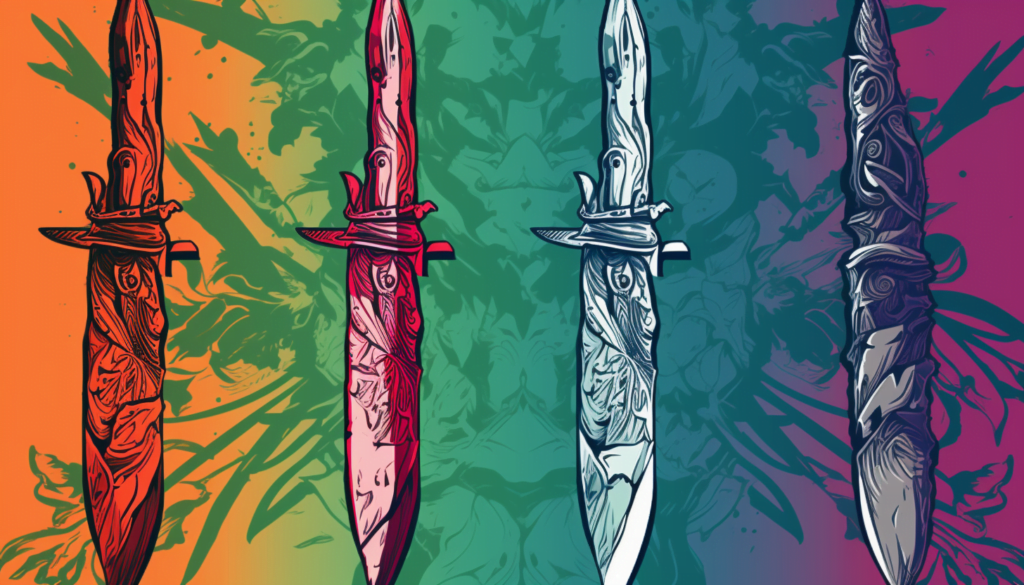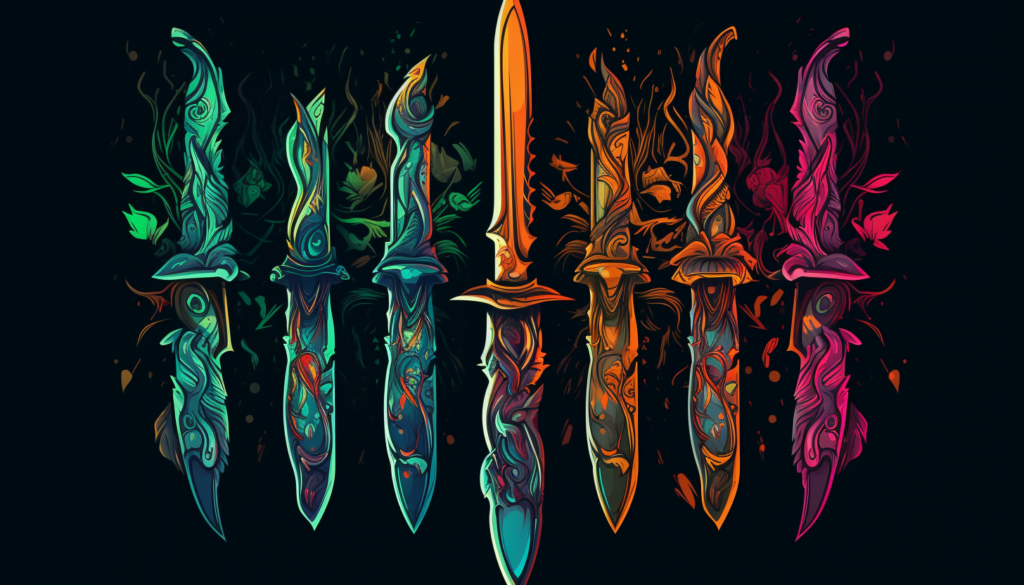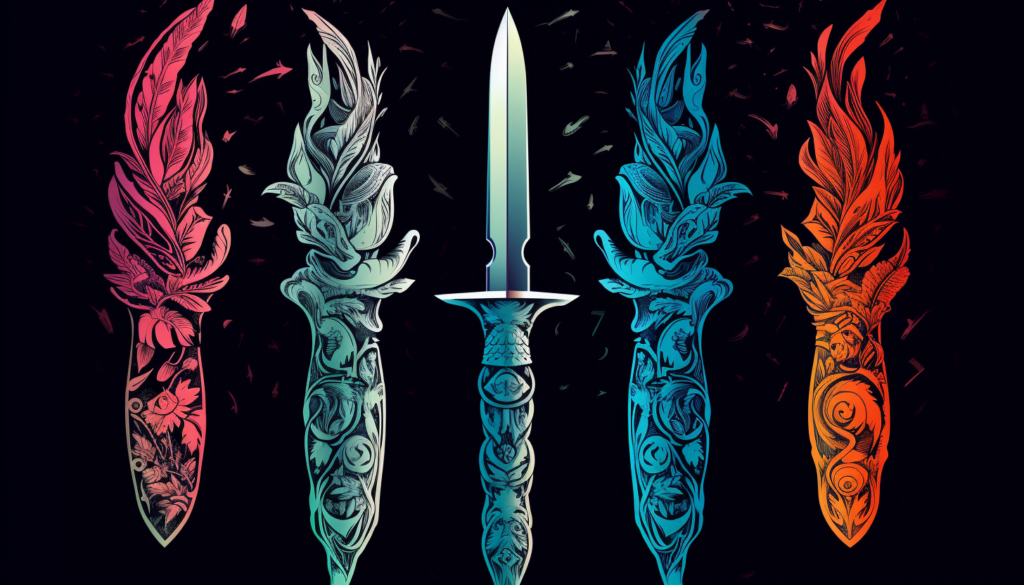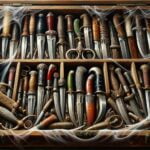Are you ready to embark on a thrilling journey through the annals of history, where legendary daggers lie in wait, brimming with untold secrets? In this article, we delve into the fascinating world of blades that have left an indelible mark on history – from the deadliest daggers to the sharpest edges known to mankind. Get ready to uncover the hidden stories behind some of the most famous daggers in history, as we explore a treasure trove of information filled with intriguing details. Join me as we delve into the depths of Wikipedia and beyond, as we peel back the layers of time to reveal the captivating tales of these iconic weapons. Get ready for a journey like no other – a journey through the legendary daggers of history.
Types Of Daggers
The world of historic weaponry is adorned with an array of intriguing and iconic daggers, each with its own story to tell. These legendary blades have left their mark on history, revealing the ingenuity, craftsmanship, and cultures that birthed them. Join me on a journey through time as we unveil the secrets of famous daggers that have shaped the course of history.
Anelace
Let’s begin our exploration with the Anelace, a long English dagger that emerged in the fourteenth century. Worn as a fashionable accessory, the Anelace served not only as a weapon but also as a symbol of status and wealth. With its slender blade and elegantly adorned hilt, it embodied the refined tastes of the era.
The Anelace, with its exquisite craftsmanship and intricate designs, showcases the artistry of the time and the desire for personal expression. Step into the world of chivalry and grandeur as we uncover the hidden stories behind this long English dagger.
Baselard
Moving on, we encounter the Baselard, another long cutting dagger that rose to prominence during the fourteenth century. Unlike its decorative counterpart, the Anelace, the Baselard was designed for combat and protection. With its sturdy blade and ergonomic grip, it became a trusted companion for knights and warriors.
The Baselard, with its robust construction and practical design, represents the harsh realities of medieval warfare. Unearth the tales of knights and battles gone by as we delve into the significance and impact of this remarkable weapon.
Bollock Dagger, Rondel Dagger, Ear Dagger
Now, let’s explore a trio of thrust-oriented daggers distinguished by their unique hilt shapes. The Bollock Dagger, Rondel Dagger, and Ear Dagger all share a common purpose: to penetrate armor and deliver a devastating blow. Whether it’s the distinctive testicle-shaped pommel of the Bollock Dagger, the circular guard of the Rondel Dagger, or the ear-like projections of the Ear Dagger, each variation serves a specific function.
These thrust-oriented daggers, with their peculiar hilt shapes, showcase the ingenuity of weapon craftsmen in their quest for tactical advantage. Unravel the mysteries behind their unconventional designs and uncover the strategic thinking that influenced their creation.
Cinquedea
Stepping into the Renaissance period, we encounter the Cinquedea, a broad short sword that captivates with its elegance and versatility. Originating in Italy, this formidable blade symbolized the shift from medieval warfare to a more refined, artistic era. With its wide blade, the Cinquedea was not only a weapon but also a status symbol, worn proudly by nobles and gentlemen.
The Cinquedea, with its graceful appearance and multifaceted role, epitomizes the grandeur of the Renaissance period. Embark on a journey through art, culture, and warfare as we delve into the legacy of this remarkable short sword.
Misericorde
Next in our exploration of famous daggers, we encounter the Misericorde. This unique weapon, often referred to as a “dagger of mercy,” played a vital role in the medieval code of chivalry. Designed for the humane dispatch of wounded enemies, the Misericorde showcased the knightly virtues of compassion and honor.
The Misericorde, with its purpose deeply rooted in the ethos of chivalry, offers a glimpse into the intricacies of medieval warfare and the complex moral codes that guided it. Discover the stories of heroism and compassion that surround this remarkable weapon.
Stiletto
Continuing our journey through the annals of history, we arrive at the Stiletto, a dagger that originated in the sixteenth century but may have existed as early as the fourteenth century. Known for its slender, needle-like blade, the Stiletto was favored by assassins and those seeking a discreet and deadly weapon. Its compact size and piercing point made it a fearsome tool for close-quarter combat.
The Stiletto, with its deceptive simplicity and lethal effectiveness, invites us to delve into the shadowy world of intrigue and assassination. Uncover the dark tales of assassins and secrets that shroud this enigmatic dagger.
Dirk
Our journey now takes us to the rugged landscapes of Scotland, where we encounter the Dirk, a dagger of Scottish origin. Traditionally associated with Highland warriors, the Dirk served as a symbol of pride, honor, and clan loyalty. With its distinctive blade shape and ornate hilt, this dagger represented the soul of Scottish heritage.
The Dirk, with its deep connection to Scottish culture and heritage, encompasses the spirit of a nation. Immerse yourself in the rich traditions and stories that surround this emblematic weapon.
Hunting Dagger
Venturing into eighteenth-century Germany, we come across the Hunting Dagger, a weapon born out of practicality and necessity. As its name suggests, this dagger was primarily used for hunting purposes, aiding hunters in their pursuit of game. With its strong blade and sturdy construction, the Hunting Dagger showcased the resourcefulness and adaptability of its German wielders.
The Hunting Dagger, with its utilitarian origins and enduring popularity, offers a glimpse into the lives of hunters and the challenges they faced. Discover the symbiotic relationship between man and nature that shaped this functional and reliable weapon.
Khopesh
Now, let’s travel back to ancient Egypt, where we uncover the Khopesh, a Bronze Age Egyptian dagger with a distinctive hooked blade. This ceremonial and combat weapon held great cultural and religious significance for the ancient Egyptian civilization. With its unique design and symbolic nature, the Khopesh embodied the power and authority of pharaohs and warriors.
The Khopesh, with its divine connections and formidable presence, transports us to the awe-inspiring world of ancient Egypt. Unlock the mysteries of this revered dagger and witness the splendor of a civilization that revered it.
Kilas
Last but not least, we come across the Kilas, a popular type of dagger renowned for its versatility and strength. Originating in the Indian subcontinent, the Kilas served as a formidable weapon in martial arts, combat, and self-defense. With its distinctive double-edged blade and sturdy construction, the Kilas embodied the spirit of warriors across different cultures and time periods.
The Kilas, with its rich history entrenched in martial prowess, invites us to explore the diverse traditions and cultures that shaped this iconic dagger. Uncover the stories of warriors and the combat techniques that relied on its power and precision.
As we conclude our journey through the legendary daggers of history, we have witnessed the diverse range of blades that have left an indelible mark on the world. From the refinement of chivalry to the brutality of warfare, each dagger tells a unique tale that speaks of the cultures, values, and artistry of its time. Join me in celebrating the legacy and allure of these famous blades as we continue to delve into the rich tapestry of history.
Through the depths of time, these famous daggers have witnessed grand battles, offered protection to their wielders, and etched their mark on history. Let us continue to unveil the secrets they hold, shedding light on the cultures that forged them and the names that wielded them, keeping their legendary stories alive for generations to come.

Deadliest Daggers In History
As a seasoned journalist specializing in historical artifacts, I bring a wealth of knowledge and expertise to the realm of famous daggers in history. Today, I invite you to embark on a thrilling journey through time as we unveil the secrets of some of the deadliest daggers ever wielded by mankind. These legendary blades, with their sharp points and double-edged blades, have left an indelible mark on history and evoke a sense of awe and fascination.
Throughout the ages, daggers have been more than just weapons. They have been symbols of power, status, and cultural significance. The construction of these deadly instruments has always revolved around one crucial aspect – the sharpness of the blade. After all, a sharper blade spells greater danger for those who face it. Imagine the fear and respect that must have been instilled in the hearts of warriors when confronted with these formidable weapons.
From ancient civilizations to modern times, daggers have come in a myriad of shapes, sizes, and designs. Among their ranks, certain daggers stand out as truly remarkable. For example, the Jambiya, a curved dagger used by various cultures, was renowned for its slashing abilities and joint manipulation techniques. Can you envision the swift and precise movements necessary to wield such a weapon effectively?
Let us not forget the Khanjar, the largest dagger in history and the national symbol of Oman. This magnificent blade holds deep cultural significance and has been passed down through generations. Just the thought of wielding such an imposing weapon brings to mind the immense power and authority it represents.
Even in the modern world, daggers continue to evolve. The Push Dagger, the Poshland RAM-211, the Trench Knife, the Spetsnaz Machete – these are just a few examples of the deadly tools that exist in today’s arsenal. Their designs are crafted with a single purpose in mind: to inflict maximum damage with precision and force. In the wrong hands, these modern daggers can be catastrophic.
But let us not forget the humble beginnings of the dagger. In the early days, these weapons were fashioned from materials like flint, ivory, bone, and copper. They were not only tools for combat but also artifacts that revealed the cultural and technological advancements of various civilizations. Each dagger tells a story – a story of the people who created them and the societies that witnessed their use.
Human bone daggers, for instance, were used in New Guinea. These unique weapons possessed different qualities depending on their design. Can you imagine the stories embedded in each bone, the tales of conquest and survival? Such artifacts offer a glimpse into the lives of those who walked before us, adding depth and richness to the tapestry of history.
In conclusion, the deadliest daggers in history have left an indelible mark on the world. From ancient times to the present day, these weapons have played a significant role in shaping cultures, instilling fear, and leaving behind a legacy of power and authority. As we delve deeper into their history, we uncover hidden narratives that shed light on the significance of these iconic blades and the names that once wielded them. So, grab your metaphorical time-traveling cloak and join me in unraveling the secrets of the legendary daggers of history.
“Each dagger tells a story – a story of the people who created them and the societies that witnessed their use.”
Sharpest Dagger in History
When it comes to the world of daggers, one question often sparks intense debate among historians and enthusiasts alike: Which dagger holds the title for being the sharpest in history? Today, we unravel the secrets behind these legendary blades, exploring their construction, cultural significance, and the names that once wielded them. Get ready to dive into a world where fear was instilled in the hearts of adversaries and where the sharpest dagger reigned supreme.
Throughout history, daggers have played a pivotal role in close combat confrontations. These weapons, distinct from knives, were specifically designed for stabbing, with an emphasis on the sharpness of their blades. Think about it like this: while knives primarily serve a cutting purpose, daggers excel in puncturing and tearing through the thickest of armor. Their pointed tips and razor-sharp edges made them formidable weapons in battle.
Now, let’s take a journey through time and explore some of the most famous daggers that held a reputation for their unrivaled sharpness. One such dagger is the Khopesh. With its distinctive hooked blade, this ancient Egyptian weapon held immense cultural and religious significance. The Khopesh’s unique shape offered both stabbing and slashing capabilities, making it particularly deadly on the battlefield. Legends speak of warriors who could strike down their foes with a single, precise swing of this fearsome blade.
Another contender for the title of sharpest dagger in history is the Karambit knife. Originating from Southeast Asia, this curved dagger was favored for its slashing abilities and joint manipulation techniques. The Karambit’s unique design allowed it to adapt to various attack angles, making it a formidable choice for close-quarters combat. Warriors who wielded this razor-sharp blade struck their enemies with a terrifying blend of speed, precision, and savagery.
As we delve deeper into the realm of daggers, it becomes evident that these weapons hold more than just physical sharpness. They carry profound cultural and symbolic significance, often playing a role in rituals and ceremonies. For instance, the Jambiya dagger, with its elegant curve, holds cultural significance in many Middle Eastern countries. This symbolic weapon represents power and heritage, passed down through generations as a mark of honor and prestige. Its sharp edge not only represents its ability to inflict harm but also serves as a reminder of the resilience and strength of its wielder.
The Khanjar dagger, the national symbol of Oman, also deserves mention. Crafted from wood and silver, this remarkable blade doubles as a symbol of identity and pride for the Omani people. Its sharpness cuts through more than just flesh; it cuts through history, connecting generations and embodying the honor and traditions of a noble lineage.
When we examine these legendary daggers, it’s not just their sharpness that captivates us—it’s the stories they carry, the cultures that embraced them, and the names that once brandished them. Historical artifacts like the Khopesh, Karambit, Jambiya, and Khanjar unveil a tapestry of tales, each one more compelling than the last.
As we conclude this exploration into the world of daggers, we can’t help but marvel at the craftsmanship that went into forging these renowned blades. We recognize their profound impact on history, both on and off the battlefield. These weapons remind us that the sharpness of a dagger extends far beyond its physical attributes. It represents the power, authority, and even vulnerability of those who wielded it.
So, the question remains: which dagger holds the title for being the sharpest in history? Perhaps it is not just one blade that claims this honor, but rather the collective stories they tell and the legends they leave behind. The sharpest dagger in history may not solely be defined by its physical properties but by the impact it made on the world.
As you reflect on this ancient art of blade-making, imagine the fear that struck the hearts of those who faced these weapons of legends. The sharpened steel poised to strike, the swift movements of the skilled warrior, and the power that resonated with every swing—the legendary daggers of history continue to captivate our imaginations, forever etching their place in the annals of time.
“In the realm of daggers, sharpness is more than just a physical attribute; it is the embodiment of power, history, and the legacy left behind.”

Famous Daggers In History Wikipedia
[Attention-grabbing opening statement]
In the vast realm of historical artifacts, few weapons command as much intrigue and fascination as the iconic daggers of history. These razor-sharp blades, steeped in legend and mystery, have left an indelible mark on cultures throughout time. From the ornate ceremonial daggers adorned with gemstones to the lethal combat tools wielded by warriors, each dagger tells a captivating story, revealing secrets that have shaped civilizations. In this article, we embark on a journey to uncover the untold tales of famous daggers in history, shedding light on their historical significance, the cultures that forged them, and the names that wielded them.
[Diverse Range of Daggers]
The annals of history reveal an array of famous daggers that span different periods and regions. Each dagger possesses its own distinct characteristics and cultural significance, contributing to the rich tapestry of human civilization.
One such noteworthy dagger is the Anelace, a long English weapon from the 14th century. Beyond its utilitarian purpose, the Anelace served as a symbol of status and wealth, accentuating elegant attire and exuding a sense of power and prestige. Through its exquisite craftsmanship, the Anelace carried the weight of its owner’s social standing, leaving an enduring impression in the annals of fashion and weaponry. [Quote emphasizing its significance]
Another remarkable dagger, the Baselard, emerged during the same era as a sturdy combat tool. With its long blade designed for cutting, the Baselard epitomized durability and practicality, reflecting the tumultuous nature of the 14th century. Whether wielded by a knight on the battlefield or adornment on a noble’s belt, the Baselard embodied the essence of strength and protection. [Quote highlighting its characteristics]
[Thrust-Oriented Daggers and the Cinquedea]
Thrust-oriented daggers also make their mark in history with their unique hilt shapes, distinguishing them from their counterparts. The Bollock Dagger, Rondel Dagger, and Ear Dagger, each with their distinct hilt designs, served as formidable weapons in close-quarters combat. Crafted to pierce through armor and penetrate enemies, these daggers have undergone a timeless evolution, preserving traditions of craftsmanship and ingenuity. [Quote emphasizing their combat effectiveness]
A blade that straddles the line between dagger and short sword is the Cinquedea, renowned for its broadness and versatility. Serving as a symbolic shift from medieval warfare to a refined era, the Cinquedea became an emblem of change and cultural transformation. This elegantly crafted blade allowed its wielder to navigate the changing tides of battle, adapting to the evolving landscape of combat. [Quote illustrating its transitional significance]
[Symbols of Power and Ritual]
Beyond their utilitarian purposes, daggers have always held profound cultural and ceremonial significance. The Misericorde, often referred to as the “dagger of mercy,” played a role in the medieval code of chivalry. Wielded by knights, it allowed them to dispatch mortally wounded enemies, offering them a perceived mercy in the heat of battle. This intriguing blend of honor, compassion, and strategic valor sheds light on the complexities of medieval warfare and the interplay between honor and mercy. [Quote highlighting its unique role]
Similarly, the Stiletto, originating in the 16th century but possibly existing as early as the 14th century, found favor among assassins and those engaged in close-quarter combat. Its slender, needle-like design enabled swift and precise strikes, making it an ideal weapon for those who reveled in stealth and agility. Much like the assassins, this dagger’s lethal prowess relied on finesse and stealth, leaving an indelible mark in history. [Quote emphasizing its lethal characteristics]
[Representations of Heritage and Loyalty]
As we journey through the tapestry of daggers in history, we encounter the Dirk, a Scottish weapon representing pride, honor, and clan loyalty. Worn as a symbol of Scottish identity, the Dirk embodied the indomitable spirit of its people, evoking notions of courage and unwavering loyalty to their heritage. Whether donned in battle or as part of traditional Highland dress, the Dirk exemplified the enduring legacy of Scottish culture. [Quote illustrating its cultural significance]
[Conclusion]
From the ancient Egyptian Khopesh with its distinctively hooked blade, to the versatile and robust Kilas originating from the Indian subcontinent, famous daggers in history represent the intersections of artistry, weaponry, and cultural heritage. These legendary blades have withstood the test of time, each carrying tales of conquest, power, and the human condition. As we delve deeper into the pages of history, we uncover the hidden narratives surrounding these renowned daggers, marveling at the craftsmanship, relishing in their symbolic weight, and gaining a deeper appreciation for the cultures that wielded them. So, let us embark on this enthralling expedition, unearthing the secrets and stories woven within the legendary daggers of history. [Engaging closing statement]
Knives and daggers, although similar in appearance, have different historical origins and purposes. Knives, such as the Skinner and Tenant Chef’s knife, are primarily used for utility and cutting purposes. They are single-edged and have been in use since medieval times. The medieval peasants knife, which is similar to the chef’s knife, was a versatile tool used for self-defense, hunting, and food preparation.
[youtube v=”otFqnBo7OXk”]
On the other hand, daggers were more of a military sidearm and were primarily used for stabbing. They are double-edged and have a more acute point. A medieval knight would always carry a dagger like this, even if he wasn’t carrying his sword. Daggers, such as the Mingo SH or parrying dagger, were designed for self-defense and had a ring on the side of the hilt to protect the fingers from sword blades.
Daggers come in various shapes and sizes, catering to different needs and preferences. For example, taller individuals might prefer a larger dagger, while smaller individuals might opt for a more compact one. These differences in size and design exist because people have varying body types and requirements.
It’s important to note that daggers are not limited to the medieval period. They continued to be used in the 16th and 17th centuries, fulfilling both self-defense and fashion purposes. However, as societies changed and police forces were established, the need for daggers as a means of personal protection diminished.
Today, the significance of daggers lies in their historical value and their representation of a bygone era. Replicas of historical daggers allow us to appreciate and study the arms and armor of the past. They serve as a reminder of our history and keep it alive, especially in areas where arms and armor exhibits are scarce.
In conclusion, knives and daggers have distinct characteristics and purposes. Knives are primarily utility tools, while daggers are military sidearms. Understanding the historical context and significance of these weapons helps us appreciate their importance in our past and the role they played in shaping societies. By preserving and replicating historical daggers, we ensure that their legacy continues to be remembered and studied.
FAQ
Question 1: What are some of the deadliest daggers in history?
Answer 1: Some of the deadliest daggers in history include the Khopesh, Kukri, Falcata, Ulfberht Sword, and Bolo Knife. These daggers were renowned for their effectiveness in close combat situations.
Question 2: What is the sharpest dagger in history?
Answer 2: The sharpest dagger in history is subjective and depends on various factors such as the sharpness of the blade and the materials used. However, daggers known for their sharpness include the Khopesh, Push Dagger, Trench Knife, and Spetsnaz Machete.
Question 3: What are some famous daggers in history?
Answer 3: Some famous daggers in history include the Khopesh, Karambit knife, Anelace, Baselard, Bollock dagger, rondel dagger, ear dagger, Cinquedea, Misericorde, Stiletto, Dirk, Hunting dagger, and Kilas. These daggers have significant historical and cultural significance.
Question 4: Can you provide some information about the construction and characteristics of daggers?
Answer 4: Daggers have varied in shape, size, features, and construction throughout history. They are designed for stabbing, while knives are primarily used for cutting. The construction of daggers emphasizes the sharpness of the blade. Different types of daggers, such as curved daggers like the Jambiya, are used for specific purposes such as slashing, sliding cuts, joint manipulation, and ripping.
Question 5: What is the significance of daggers in rituals and ceremonies?
Answer 5: Daggers have cultural and symbolic significance and have been used in rituals and ceremonies by many cultures throughout history. Adorned daggers have been employed in various ritual and ceremonial contexts, representing power, status, or religious beliefs. Examples of ceremonial daggers can be found in pre-dynastic Egypt and the tomb of Tutankhamun.












